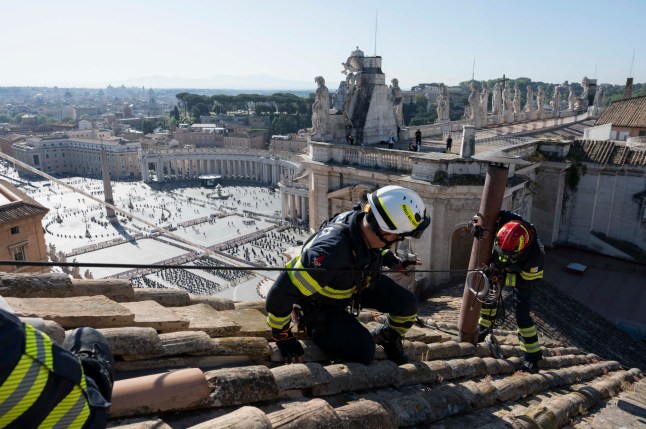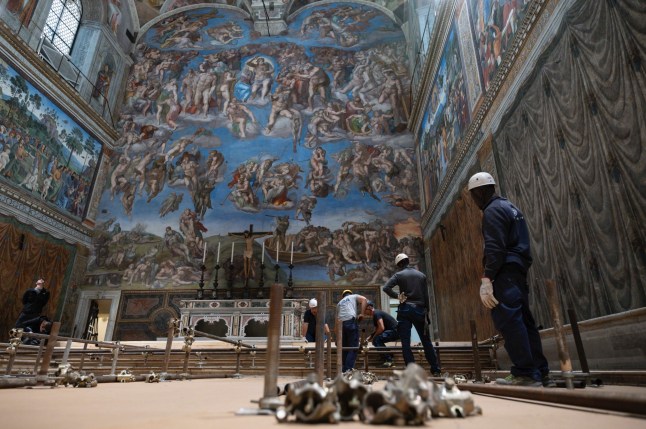The famous chimney that will signify to the world the election of a new pope has been installed on the roof of the Sistine Chapel ahead of the conclave next week.
Vatican firefighters were seen fixing the chimney,which is a key moment in the preparation for the May 7 vote to name Pope Francis’ successor.
After every two rounds of voting in the Sistine Chapel,the cardinals’ ballots are burned in a special furnace to indicate the results to the millions watching rolling news coverage around the globe.
If no new pope has been chosen,the ballots are mixed with cartridges containing potassium perchlorate,anthracene (a component of coal tar) and sulphur to produce black smoke. But if there is a new bishop of Rome,the ballots are mixed with potassium chlorate,lactose and chloroform resin to produce white smoke.

Vatican firefighters install the chimney before the start of the conclave on May 7(Picture: AFP via Getty)

Preparations continue as chimney installed on the roof of the Sistine Chapel (Picture: Anadolu via Getty Images)
It was not until the fifth ballot,on March 13,2013,that white smoke billowed from the chimney following the election of Cardinal Jorge Mario Bergoglio as successor to Pope Benedict XVI.
The Argentine,history’s first pontiff from Latin America,was introduced to the world as Pope Francis a short time later from the loggia of St Peter’s Basilica.
This year’s conclave takes place in the wake of his death aged 88 on Easter Monday.
 Cardinals stand during late Pope Francis’ funeral ceremony at St Peter’s Square at the Vatican (Picture: AFP via Getty)On the first day,the cardinals participate in an opening Mass and an initial vote takes place in the evening,often taken as a symbolic poll in which voters name someone they have particular admiration for.From then on,there are two sessions every day – one in the morning and another in the afternoon – each comprising two votes.The cardinals are instructed to mask their own handwriting while completing a card inscribed ‘Eligo in Summum Pontificem’ – ‘I elect as Supreme Pontiff’.They approach the altar one by one and say: ‘I call as my witness,Christ the Lord who will be my judge,that my vote is given to the one who,before God,I think should be elected.’The folded ballot is placed on a round plate and slid into an oval urn.After the votes are counted and the outcomes announced,the papers are bound together with a needle and thread,each ballot pierced through the word ‘Eligo’.Then they are burned with a chemical to send black smoke (meaning no new pope) or white (meaning yes,a pope has been chosen) out of the Sistine Chapel’s chimney.Cardinals have been arriving in Rome in the week since to participate in pre-conclave discussions – called general congregations – about the needs of the Catholic Church going forward.These consultations include all cardinals,including those over age 80 who are ineligible to vote in the conclave itself.In recent days,they have heard reports about the Vatican’s dire financial situation, and have had the chance to speak individually about priorities going forward and problems they percieved in Francis’ pontificate.Francis was seen by some as a somewhat divisive pope.Some admired his focus on the poor and marginalised,but others criticised him of ‘sowing confusion among the faithful’ on issues of morality and church law.These conservatives and traditionalists,who are not believed to have a majority among the 135 cardinal electors,are hoping a new pope will reassert core church teachings and act as a stabilising figure in the Vatican bureaucracy.
Cardinals stand during late Pope Francis’ funeral ceremony at St Peter’s Square at the Vatican (Picture: AFP via Getty)On the first day,the cardinals participate in an opening Mass and an initial vote takes place in the evening,often taken as a symbolic poll in which voters name someone they have particular admiration for.From then on,there are two sessions every day – one in the morning and another in the afternoon – each comprising two votes.The cardinals are instructed to mask their own handwriting while completing a card inscribed ‘Eligo in Summum Pontificem’ – ‘I elect as Supreme Pontiff’.They approach the altar one by one and say: ‘I call as my witness,Christ the Lord who will be my judge,that my vote is given to the one who,before God,I think should be elected.’The folded ballot is placed on a round plate and slid into an oval urn.After the votes are counted and the outcomes announced,the papers are bound together with a needle and thread,each ballot pierced through the word ‘Eligo’.Then they are burned with a chemical to send black smoke (meaning no new pope) or white (meaning yes,a pope has been chosen) out of the Sistine Chapel’s chimney.Cardinals have been arriving in Rome in the week since to participate in pre-conclave discussions – called general congregations – about the needs of the Catholic Church going forward.These consultations include all cardinals,including those over age 80 who are ineligible to vote in the conclave itself.In recent days,they have heard reports about the Vatican’s dire financial situation, and have had the chance to speak individually about priorities going forward and problems they percieved in Francis’ pontificate.Francis was seen by some as a somewhat divisive pope.Some admired his focus on the poor and marginalised,but others criticised him of ‘sowing confusion among the faithful’ on issues of morality and church law.These conservatives and traditionalists,who are not believed to have a majority among the 135 cardinal electors,are hoping a new pope will reassert core church teachings and act as a stabilising figure in the Vatican bureaucracy.United News - unews.co.za